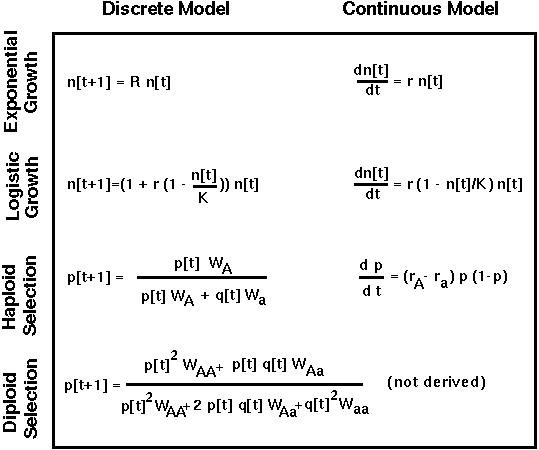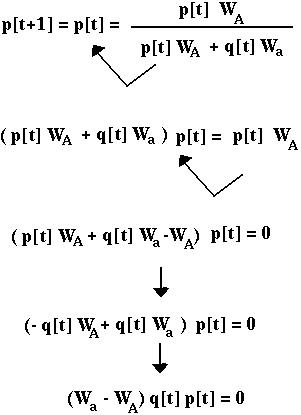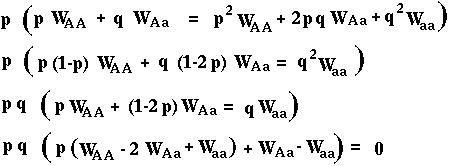
Methods of Analysis. II. Equilibria



What are the equilibria of the following equations?



In the discrete model, we must find the value of p for which p[t+1]=p[t].

For p[t+1] to equal p[t], p[t] must equal either zero or one. The population will be at equilibrium when the population is fixed on the a or A allele. (In the special case where WA=Wa, allele frequencies do not change regardless of p.)
Equilibrium values are often denoted by a hat; here  =1 and
=1 and  =0 are the only equilibria.
=0 are the only equilibria.
In the continuous model, dp/dt = (rA-ra) p (1-p)=0 only when p or 1-p equal zero (or rA=ra), as in the discrete model.


When p[t+1]=p[t] (i.e. the allele frequencies remain constant)
 EQUILIBRIUM
EQUILIBRIUM
To determine the equilibria for the diploid model, we must find the solution to:

Try solving for p yourself.
If you get stuck, follow these steps:

From this algebra we learn that p[t+1] will only equal p[t] in the diploid model if p=0, p=1, or

Note: Unlike the haploid genetic model, the diploid genetic model can have an equilibrium between 0 and 1. This is known as a polymorphic equilibrium.


Special note: Equilibria are not always biologically valid.
Equilibria should be checked to make sure that they conform with the assumptions of the model!
For instance, in the diploid selection model, p stands for the frequency of the A allele and hence MUST fall between zero and one.

When does the polymorphic equilibrium lie between 0 and 1?
Notice that the denominator is the sum of the numerators in  and
and  .
.
If the denominator is positive, then the numerators must both be positive for  and
and  to be greater than zero.
to be greater than zero.
If the denominator is negative, then the numerators must both be negative for  and
and  to be greater than zero.
to be greater than zero.
This implies that there are only two cases in which the polymorphic equilibrium is valid:
Examples:
 =?
=?
 =?
=?
 =?
=?
 =?
=?


The equilibria for the other models are:

Note: Unlike the haploid genetic model, the diploid genetic model can have an equilibrium between 0 and 1. This is known as a polymorphic equilibrium.
(Make sure that you understand how to determine equilibria and can derive each of above equilibria.)